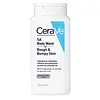What's inside
What's inside
 Key Ingredients
Key Ingredients

 Benefits
Benefits

 Concerns
Concerns

 Ingredients Side-by-side
Ingredients Side-by-side

Water
Skin ConditioningCocamidopropyl Hydroxysultaine
CleansingGlycerin
HumectantSodium Lauroyl Sarcosinate
CleansingNiacinamide
SmoothingGluconolactone
Skin ConditioningSodium Methyl Cocoyl Taurate
CleansingPEG-150 Pentaerythrityl Tetrastearate
EmulsifyingSalicylic Acid
MaskingSodium Benzoate
MaskingZea Mays Oil
EmulsifyingDisodium EDTA
Sodium Lauroyl Lactylate
EmulsifyingCeramide NP
Skin ConditioningCholecalciferol
Phytosphingosine
Skin ConditioningCholesterol
EmollientSodium Hyaluronate
HumectantXanthan Gum
EmulsifyingCarbomer
Emulsion StabilisingCeramide EOP
Skin ConditioningWater, Cocamidopropyl Hydroxysultaine, Glycerin, Sodium Lauroyl Sarcosinate, Niacinamide, Gluconolactone, Sodium Methyl Cocoyl Taurate, PEG-150 Pentaerythrityl Tetrastearate, Salicylic Acid, Sodium Benzoate, Zea Mays Oil, Disodium EDTA, Sodium Lauroyl Lactylate, Ceramide NP, Cholecalciferol, Phytosphingosine, Cholesterol, Sodium Hyaluronate, Xanthan Gum, Carbomer, Ceramide EOP
Water
Skin ConditioningPropanediol
SolventPerlite
AbsorbentPumice
AbrasiveGluconolactone
Skin ConditioningParfum
MaskingGeraniol
PerfumingLimonene
PerfumingGlycerin
HumectantRhamnose
HumectantGlucomannan
Skin ConditioningGlucose
HumectantAnhydroxylitol
HumectantXylitylglucoside
HumectantGlucuronic Acid
BufferingXylitol
HumectantCitric Acid
BufferingSodium Hydroxide
BufferingSodium Benzoate
MaskingPhenoxyethanol
PreservativePotassium Sorbate
PreservativePanthenol
Skin ConditioningCyanocobalamin
Skin ConditioningAmmonium Lauryl Sulfate
CleansingCocamidopropyl Betaine
CleansingCoco-Glucoside
CleansingAcrylates/Palmeth-25 Acrylate Copolymer
Xanthan Gum
EmulsifyingStyrene/Acrylates Copolymer
Water, Propanediol, Perlite, Pumice, Gluconolactone, Parfum, Geraniol, Limonene, Glycerin, Rhamnose, Glucomannan, Glucose, Anhydroxylitol, Xylitylglucoside, Glucuronic Acid, Xylitol, Citric Acid, Sodium Hydroxide, Sodium Benzoate, Phenoxyethanol, Potassium Sorbate, Panthenol, Cyanocobalamin, Ammonium Lauryl Sulfate, Cocamidopropyl Betaine, Coco-Glucoside, Acrylates/Palmeth-25 Acrylate Copolymer, Xanthan Gum, Styrene/Acrylates Copolymer
Ingredients Explained
These ingredients are found in both products.
Ingredients higher up in an ingredient list are typically present in a larger amount.
Gluconolactone is a PHA. PHAs are a great gentle alternative to traditional AHAs.
When applied, Gluconolactone has the same affect on skin as AHAs such as lactic acid. It helps dissolve the dead skin cells in the top layer of your skin. This improves texture and brightens the skin.
PHAs are more gentle than AHAs due to their larger structure. They do not penetrate as deeply as AHAs and take a longer time to dissolve dead cells. Studies show PHAs do not cause as much irritation.
Gluconolactone has some interesting properties:
In a 2004 study, Gluconolactone was found to prevent UV damage in mouse skin cells and has not been found to increase sun sensitivity. However, we still recommend wearing SPF daily.
This ingredient is is an created by reacting gluconic acid with an alcohol.
Learn more about GluconolactoneGlycerin is already naturally found in your skin. It helps moisturize and protect your skin.
A study from 2016 found glycerin to be more effective as a humectant than AHAs and hyaluronic acid.
As a humectant, it helps the skin stay hydrated by pulling moisture to your skin. The low molecular weight of glycerin allows it to pull moisture into the deeper layers of your skin.
Hydrated skin improves your skin barrier; Your skin barrier helps protect against irritants and bacteria.
Glycerin has also been found to have antimicrobial and antiviral properties. Due to these properties, glycerin is often used in wound and burn treatments.
In cosmetics, glycerin is usually derived from plants such as soybean or palm. However, it can also be sourced from animals, such as tallow or animal fat.
This ingredient is organic, colorless, odorless, and non-toxic.
Glycerin is the name for this ingredient in American English. British English uses Glycerol/Glycerine.
Learn more about GlycerinSodium Benzoate is a preservative. It's used in both cosmetic and food products to inhibit the growth of mold and bacteria. It is typically produced synthetically.
Both the US FDA and EU Health Committee have approved the use of sodium benzoate. In the US, levels of 0.1% (of the total product) are allowed.
Sodium benzoate works as a preservative by inhibiting the growth of bacteria inside of cells. It prevents the cell from fermenting a type of sugar using an enzyme called phosphofructokinase.
It is the salt of benzoic acid. Foods containing sodium benzoate include soda, salad dressings, condiments, fruit juices, wines, and snack foods.
Studies for using ascorbic acid and sodium benzoate in cosmetics are lacking, especially in skincare routines with multiple steps.
We always recommend speaking with a professional, such as a dermatologist, if you have any concerns.
Learn more about Sodium BenzoateWater. It's the most common cosmetic ingredient of all. You'll usually see it at the top of ingredient lists, meaning that it makes up the largest part of the product.
So why is it so popular? Water most often acts as a solvent - this means that it helps dissolve other ingredients into the formulation.
You'll also recognize water as that liquid we all need to stay alive. If you see this, drink a glass of water. Stay hydrated!
Learn more about WaterXanthan gum is used as a stabilizer and thickener within cosmetic products. It helps give products a sticky, thick feeling - preventing them from being too runny.
On the technical side of things, xanthan gum is a polysaccharide - a combination consisting of multiple sugar molecules bonded together.
Xanthan gum is a pretty common and great ingredient. It is a natural, non-toxic, non-irritating ingredient that is also commonly used in food products.
Learn more about Xanthan Gum